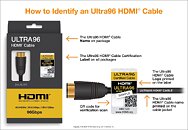- Joined
- May 21, 2024
- Messages
- 1,471 (3.62/day)
HDMI Forum, Inc. today announced the release of Version 2.2 of the HDMI Specification. Higher 96 Gbps bandwidth and next-gen HDMI Fixed Rate Link technology provide optimal audio and video for a wide range of device applications. An end-user can be assured that their displays support a native video format in the best
way possible and deliver a seamless and reliable experience. Higher resolutions and refresh rates are supported including up to 12K@120 and 16K@60. Additionally, more high-quality options are supported including uncompressed full chroma formats such as 8K@60/4:4:4 and 4K@240/4:4:4 at 10-bit and 12-bit color.
"The HDMI Forum is proud to release the new HDMI 2.2 Specification to enable higher performance capabilities and features for exciting and immersive new solutions and products," said Chandlee Harrell, president of the HDMI Forum. "And the introduction of the new Ultra96 feature name will help consumers and end-users ensure their product's maximum bandwidth is supported."


"Ultra96" is a feature name that manufacturers are encouraged to use to indicate a product supports a maximum of 64 Gbps, 80 Gbps or 96 Gbps bandwidth in compliance with the HDMI 2.2 Specification. Products that market or display the Ultra96 feature name require the Ultra96 HDMI Cable to ensure a product's maximum bandwidth is properly supported. The new Ultra96 HDMI Cable supports up to 96 Gbps and all HDMI 2.2 applications. The current Ultra High Speed HDMI Cable is applicable for system configurations supporting up to 48 Gbps maximum bandwidth.
The Ultra96 HDMI Cable, just like the Ultra High Speed HDMI Cable, is part of the HDMI Cable Certification Program requiring each model length to be tested and certified and display a Certification Label.
Also included in the new specification is Latency Indication Protocol (LIP) for improving audio and video synchronization, especially for multiple-hop system configurations such as those with an audio video receiver or soundbar.
View at TechPowerUp Main Site | Source
way possible and deliver a seamless and reliable experience. Higher resolutions and refresh rates are supported including up to 12K@120 and 16K@60. Additionally, more high-quality options are supported including uncompressed full chroma formats such as 8K@60/4:4:4 and 4K@240/4:4:4 at 10-bit and 12-bit color.
"The HDMI Forum is proud to release the new HDMI 2.2 Specification to enable higher performance capabilities and features for exciting and immersive new solutions and products," said Chandlee Harrell, president of the HDMI Forum. "And the introduction of the new Ultra96 feature name will help consumers and end-users ensure their product's maximum bandwidth is supported."


"Ultra96" is a feature name that manufacturers are encouraged to use to indicate a product supports a maximum of 64 Gbps, 80 Gbps or 96 Gbps bandwidth in compliance with the HDMI 2.2 Specification. Products that market or display the Ultra96 feature name require the Ultra96 HDMI Cable to ensure a product's maximum bandwidth is properly supported. The new Ultra96 HDMI Cable supports up to 96 Gbps and all HDMI 2.2 applications. The current Ultra High Speed HDMI Cable is applicable for system configurations supporting up to 48 Gbps maximum bandwidth.
The Ultra96 HDMI Cable, just like the Ultra High Speed HDMI Cable, is part of the HDMI Cable Certification Program requiring each model length to be tested and certified and display a Certification Label.
Also included in the new specification is Latency Indication Protocol (LIP) for improving audio and video synchronization, especially for multiple-hop system configurations such as those with an audio video receiver or soundbar.
View at TechPowerUp Main Site | Source





